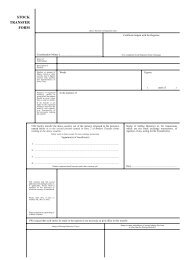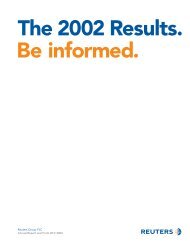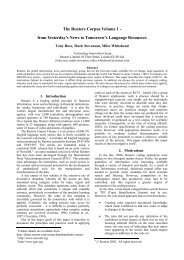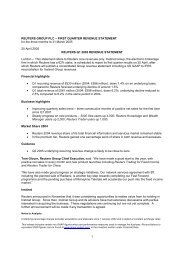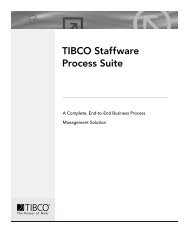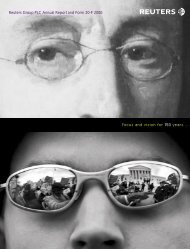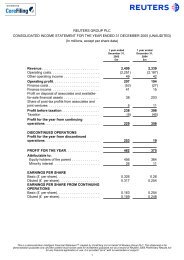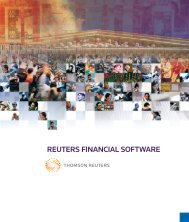REUTERS GROUP PLC ANNUAL REPORT AND ACCOUNTS 1999
REUTERS GROUP PLC ANNUAL REPORT AND ACCOUNTS 1999
REUTERS GROUP PLC ANNUAL REPORT AND ACCOUNTS 1999
You also want an ePaper? Increase the reach of your titles
YUMPU automatically turns print PDFs into web optimized ePapers that Google loves.
Summary of differences between UK and US Generally AcceptedAccounting Principles (GAAP)ACCOUNTING PRINCIPLESThese consolidated financial statements havebeen prepared in accordance with UK GAAP,which differ in certain significant respectsfrom US GAAP. A description of the relevantaccounting principles which differ materiallyis given below:Software revenue recognitionUnder UK GAAP, revenue and related directcosts from contracts for the outright sale ofsoftware systems are recognised at the time ofclient acceptance. Under US GAAP, specificrules were introduced from January 1998 forthe determination of client acceptance incases where future significant modificationsor upgrades to the software are considered tobe part of the client’s overall acceptance ofthe product. Under these rules, an amount ofrevenue is required to be deferred until thesesoftware upgrades have been delivered andaccepted by the client. Warranties providedby Reuters in connection with the delivery ofmillennium versions of software fall withinthese rules and consequently an element ofrevenue and related direct cost was deferredunder US GAAP. This policy has not beenadopted under UK GAAP.Goodwill and other acquisitionaccounting adjustmentsUK GAAP require purchased goodwill toinclude an estimate of the fair value of anycontingent consideration. Under US GAAP,contingent consideration is recognised as acomponent of goodwill when the contingencyis resolved.Under the UK GAAP, goodwill arising onacquisitions of associates is included withinthe carrying value of these investments.Under US GAAP this goodwill is includedwithin intangibles.Software development costsUnder UK GAAP, costs of developingcomputer software products are expensed inthe year in which they are incurred. UnderUS GAAP, the costs of developing computersoftware products subsequent to establishingtechnical feasibility are capitalised. Theamortisation of the capitalised costs is basedon the estimated future revenues or remainingestimated useful economic lives of theproducts involved.Employee costsSince 1990, options have been granted underReuters save-as-you-earn plans at a 20%discount. Under UK GAAP, the share issuesare recorded at their discounted price whenthe options are exercised. Under US GAAP,the discount is regarded as employeecompensation and is accrued over the vestingperiod of the grants.Taxes on incomeUnder UK GAAP, deferred taxes areaccounted for to the extent that it is consideredprobable that a liability or asset will crystallisein the foreseeable future. Under US GAAP,deferred taxes are accounted for on all timingdifferences and a valuation allowance isestablished in respect of those deferred taxassets where it is more likely than not thatsome portion will remain unrealised.Deferred tax also arises in relation to the taxeffect of the other US GAAP adjustments.DividendsUnder UK GAAP, dividends are providedfor in the year in respect of which they aredeclared or proposed. Under US GAAP,dividends and any related tax credit are giveneffect only in the period in which dividendsare formally declared.Shares held by Employee ShareOwnership Trusts (ESOTs)Under UK GAAP, shares held by the ESOTsare recorded as fixed asset investments at costless amounts written off. Under US GAAP,those shares not fully vested are regarded astreasury stock and recorded at cost as adeduction from shareholders’ equity.Fixed asset investmentsUnder UK GAAP, fixed asset investments areheld in the balance sheet at the lower of costor net realisable value. Under US GAAP,fixed asset investments which are availablefor sale are stated at fair value with unrealisedgains or losses included in the statement ofcomprehensive income.The effects of these differing accountingprinciples are shown in notes 37–40.Cash flow statementsThe cash flow statement set out on pages51–53 has been prepared in conformity withUK Financial Reporting Standard No. 1(Revised) ‘Cash Flow Statements’. Theprincipal differences between this statementand cash flow statements presented inaccordance with US Financial AccountingStandard No. 95 are as follows:1. Under UK GAAP net cash flow fromoperating activities is determined beforeconsidering cash flows from (a) returns oninvestments and servicing of finance and(b) taxes paid. Under US GAAP, net cashflow from operating activities isdetermined after these items.2. Under UK GAAP, capital expenditure isclassified separately while under US GAAP,it is classified as an investing activity.3. Under UK GAAP, dividends are classifiedseparately while under US GAAP, dividendsare classified as financing activities.4. Under UK GAAP movements in shortterminvestments are not included in cashbut classified as management of liquidresources. Under US GAAP, short-terminvestments with a maturity of threemonths or less at the date of acquisitionare included in cash.5. Under UK GAAP movements in bankoverdrafts are classified as movements incash while under US GAAP they areclassified as a financing activity.Set out below is a summary consolidatedcash flow statement under US GAAP:<strong>1999</strong> 1998 1997£M £M £MNet cash inflow from operating activities 657 795 817Net cash outflow from investing activities (409) (431) (400)Net cash outflow from financing activities (610) (764) (85)Net (decrease)/increase in cash and cash equivalents under US GAAP (362) (400) 332Net decrease in cash under UK GAAP (see notes 4–5 above) (25) (8) (31)Reuters Group <strong>PLC</strong> Annual Report <strong>1999</strong> 75



